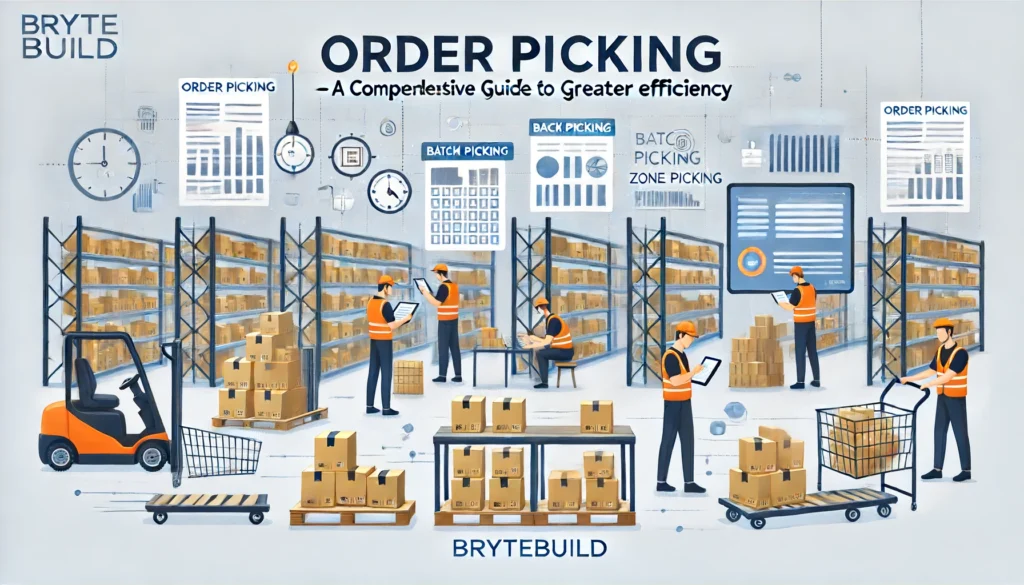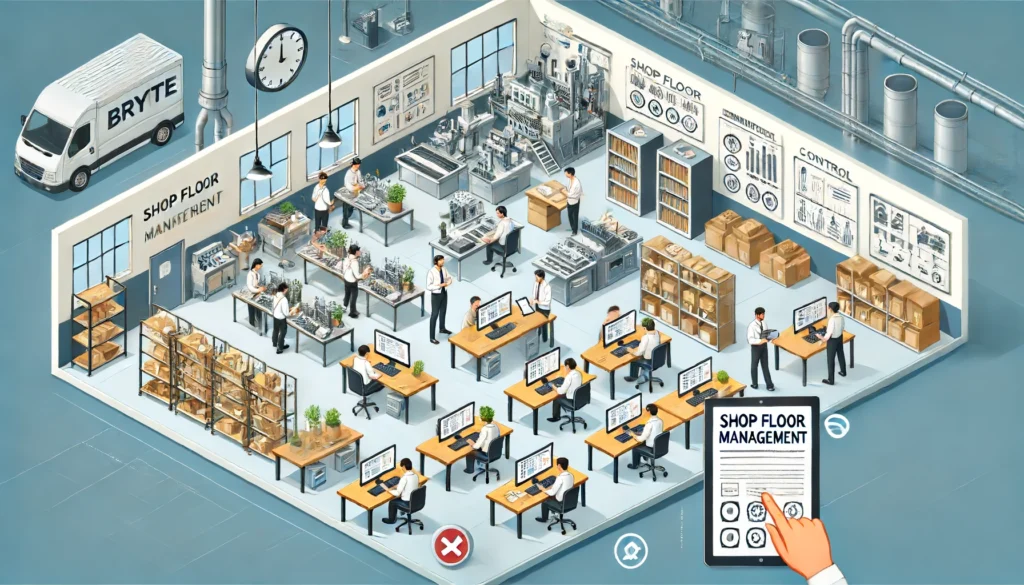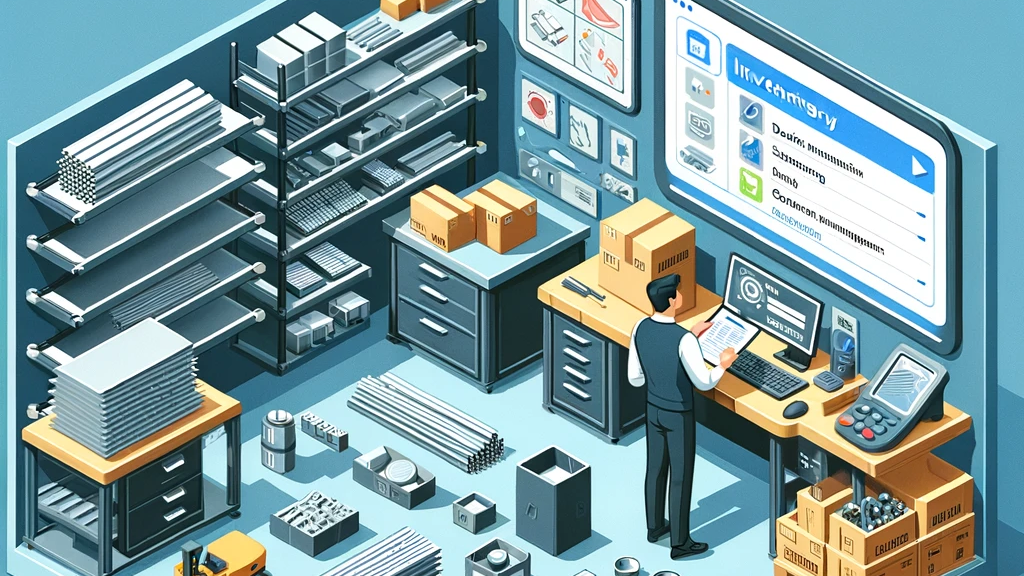An automated inventory management system is a software-based solution designed to streamline warehouse processes, optimize stock levels, and reduce inventory-related costs. This article explores the key features, benefits, and considerations for implementing an automated inventory management system.
Table of Contents
- What is an Automated Inventory Management System?
- Key Features of Automated Inventory Systems
- Benefits of Automated Inventory Management
- Choosing the Right Automated Inventory Management Software
- Enhancing Business Operations with Brytebuild
- Key Takeaways
- FAQs
What is an Automated Inventory Management System?
An automated inventory management system, also called a perpetual inventory system, is a software-based solution that automates workflows and minimizes the effort needed to manage a company’s inventory. Automated inventory management consists of various functions that are performed automatically or semi-automatically, including inventory tracking, planning, and reporting. The core of an automated inventory system is inventory management software such as MRP or ERP, with additional integrations possible to extend the system’s capabilities.
Although particularly advantageous for businesses dealing with large inventories, companies of any size can benefit from using automated inventory management systems.
Key Features of Automated Inventory Systems
While many software solutions market themselves as automated inventory systems, certain functionalities are essential for a solution to be considered truly automated. Here are the key features of an automated inventory system:
Inventory Tracking
An automated inventory system records stock movements in real-time, providing users with a complete overview of their inventory operations. This includes automated stock lot tracking and serial number tracking, which allows you to trace a product’s journey throughout the supply chain. Accurate demand forecasting is based on historical performance data, eliminating the need for frequent inventory counts.
Inventory Planning
Automated inventory systems keep up-to-date information regarding inventory levels, incoming orders, production schedules, and more, enabling accurate purchase planning. For instance, an MRP system can calculate material requirements and generate pre-filled purchase orders for missing goods, enhancing order processing speed. Functions like the master production schedule use demand forecasts to create long-term material and capacity plans.
Inventory Valuation
In an automated system, all inventory is continuously recorded along with its costs, providing a real-time overview of stock value. This includes the cost of goods sold (COGS), impacting profitability directly. Proper MRP/ERP systems automatically calculate COGS.
Reporting and Data Analytics
Automated inventory systems offer various reports and metrics related to inventory performance, including current levels, movement history, quality statistics, and critical on-hand reports. This information helps optimize inventory, preventing stockouts, overstocking, and minimizing dead stock.
Inventory-Related Notifications
Inventory notifications keep you informed about critical operations. Low stock alerts, quality inspection requirements, order status changes, and new task assignments are examples of notifications that can be set up to ensure smooth inventory management.
Automated Data Entry
Barcode scanning and other automated data capture methods reduce manual data entry, saving time and minimizing errors. This automation allows resources to be allocated to more strategic business areas.
Automated Communication
Automated systems facilitate seamless communication between employees and departments. For example, marking a batch of products as finished instantly updates stock levels and triggers low stock alerts. This immediate exchange of information streamlines inventory management processes.
Multi-Channel Synchronization
Automated inventory systems integrate with third-party apps, synchronizing data across platforms like Amazon or Shopify. This integration ensures that sales are reflected in warehouse stock levels, simplifying inventory management across multiple sales channels.
Multi-Location Management
Cloud-based inventory systems allow management of multiple warehouse locations from a single account. This scalability is crucial for growing companies, enabling seamless expansion without additional software accounts.
Benefits of Automated Inventory Management
Automated inventory management systems bring numerous benefits to businesses of all sizes and industries. Here’s a comprehensive look at how these systems improve various aspects of business operations:
Reduced Costs
Automated systems reduce operational costs by improving inventory control and eliminating manual processes. This leads to lower labour expenses, decreased carrying costs, and optimized stock levels, ultimately improving the bottom line.
Minimized Risk of Human Errors
Automation mitigates the risk of human errors common in manual inventory management, ensuring accurate and up-to-date data, reducing costly mistakes.
Optimized Stock Levels
Automated systems use historical sales data to achieve accurate demand forecasts, enabling precise material planning and effective replenishment. This optimization helps businesses allocate resources more efficiently.
Higher Visibility
Real-time inventory data provides a clear view of stock levels, enabling informed decisions about purchasing, sales, and replenishment. This visibility benefits supply chain management and warehousing processes, documenting every item.
Full Traceability
Automation offers full traceability of inventory items, making it easier to track their movements throughout the supply chain and production. This sets an effective basis for quality control, compliance, and recalls.
Faster Order Fulfillment
Optimized inventory ensures prompt responses to customer orders, increasing customer satisfaction. Improved communication across operations also speeds up fulfillment.
Better Communication
Automation facilitates better communication with other departments, employees, suppliers, and distributors. Issues can be quickly pinpointed and communicated to responsible parties, standardizing and clarifying inventory management and procurement communication.
Scalability
Automated inventory management solutions are scalable, making them indispensable for small businesses. As a business grows, the system adapts to handle increased numbers of SKUs and other inventory data.
Choosing the Right Automated Inventory Management Software
Selecting the right automated inventory management software depends on specific operational needs. Here are key
Choosing the Right Automated Inventory Management Software
Selecting the right automated inventory management software depends on specific operational needs. Here are key considerations for different types of businesses:
Small Retailers and E-commerce Businesses
Small retailers or e-commerce businesses should opt for user-friendly and cost-effective inventory management software. Key features to look for include:
- Integrations with E-commerce Platforms and POS Systems: Seamless integration with platforms like Shopify and POS systems to streamline order management.
- Real-Time Inventory Tracking: Ensures accurate stock levels and availability.
- Barcode Scanning Capabilities: Speeds up data entry and reduces errors.
- Mobile Access: Allows for on-the-go management.
- Scalability: Accommodates business growth.
- Customer Support and Training Resources: Essential for smooth software adoption and troubleshooting.
Distributors
Distributors should choose inventory management software that emphasizes streamlined supply chain operations. Key features include:
- Robust Order Management: Efficiently manages large volumes of orders.
- Real-Time Inventory Tracking: Provides up-to-date stock information.
- Supplier Integration: Simplifies the procurement process.
- Multi-Location Support: Manages inventory across multiple warehouses.
- Scalability: Grows with expanding product lines and distribution networks.
- User-Friendly Interface: Ensures ease of use for employees.
Manufacturers
Manufacturers should opt for Manufacturing ERP or MRP software, which are specifically designed for complex inventory management needs in manufacturing operations. Key features include:
- Integrated Inventory Management: Combines inventory, production, sales, procurement, and finance.
- Material Procurement and Production Planning: Optimizes resource use and ensures timely order fulfillment.
- Scalability: Adapts to increasing SKUs and production volumes.
- Real-Time Data and Analytics: Provides insights for strategic decision-making.
Enhancing Business Operations with Brytebuild
Brytebuild’s comprehensive software solutions integrate seamlessly into your existing operations, providing powerful tools for managing your inventory efficiently. Here’s how Brytebuild can transform your business:
- Warehouse Management System: Features purchase order management, delivery orders, picking, packing, and a barcoding system with QR code scanning and printing.
- Inventory Tracking: Live stock quantity updates and QR code tracking for precise inventory management.
- 3D Warehouse Viewer: Allows you to live locate items and design your warehouse layout effectively.
- Scheduling System: Plan and assign jobs seamlessly, ensuring all maintenance and operational tasks are performed on time.
- Custom Permissions: Create groups with specific access levels, ensuring operational transparency and security.
Brytebuild also offers robust production management features, including digital work instructions that follow a step-by-step system. These guides can be associated with products or created independently, ensuring all employees have the information they need to perform their tasks efficiently.
Try Brytebuild Today
Explore how Brytebuild can revolutionise your inventory management processes. Contact us for a demo or sign up for a free trial to experience the benefits firsthand.
Key Takeaways
- Automated Inventory Management: Software solutions that automate inventory-related processes.
- Key Features: Include real-time inventory tracking, data entry automation (e.g., barcode scanning), inventory planning, and multi-channel integration.
- Benefits: Reduced operational costs, minimized human errors, optimized stock levels, enhanced visibility, full traceability, faster order fulfillment, better communication, and scalability.
- Choosing the Right Software: Depends on specific business needs, whether it’s for small retailers, distributors, or manufacturers.
- Enhancing Operations with Brytebuild: Comprehensive features that streamline inventory management and improve operational efficiency.
FAQs
What is automated inventory management?
Automated inventory management is a software-based system that automates inventory-related tasks like tracking, planning, and reporting, reducing manual effort and improving accuracy.
What companies use automated inventory management?
Companies of all sizes across various industries use automated inventory management to streamline their inventory processes and improve efficiency.
What are the benefits of automated inventory management?
The benefits of automated inventory management include reduced operational costs, minimized errors, optimized stock levels, enhanced visibility, and improved order fulfillment speed.









